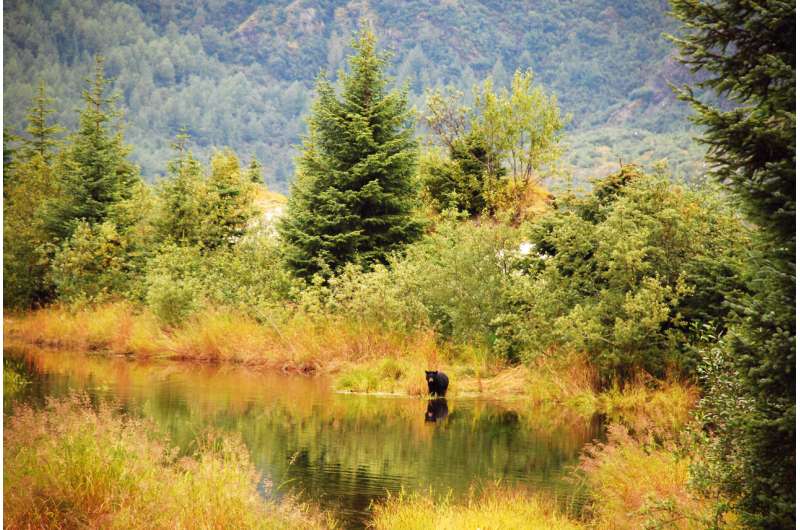This article has been reviewed according to Science X's editorial process and policies. Editors have highlighted the following attributes while ensuring the content's credibility:
fact-checked
peer-reviewed publication
trusted source
proofread
Southern Alaska's national forests key to meeting climate and conservation goals, study shows

Analyses of U.S. national forests led by Oregon State University scientists shows that increased protections for two Alaskan forests is a key to meeting climate and biodiversity goals.
In a paper published in AGU Advances, OSU College of Forestry researchers make the case that greater conservation efforts in the Tongass and Chugach national forests in southern Alaska are crucial because of their landscape integrity, high carbon stocks and wildlife habitat extent.
"More thoroughly safeguarding those forests from industrial development would contribute significantly to climate change mitigation and species adaptation in the face of the severe ecological disruption that's expected to occur over the next few decades as the climate rapidly gets warmer," said Oregon State's Bev Law, who co-led the study.
At 16.7 million acres, the Tongass is America's largest national forest. The Chugach is the second-largest at just under 7 million acres.
Not only are they the biggest national forests, they are the most intact, Law said, and provide habitat for iconic, keystone species such as the bald eagle, brown bear and gray wolf.
"Those forests are also cool and wet, with carbon stocks that are only minimally affected by wildfire, stocks that are likely to increase as the climate changes," she said. "Protecting the Tongass and Chugach is a high priority if we want to have a chance to attain global goals relating to climate and diversity of species."
Law and collaborators in the College of Forestry teamed up with researchers at Southern Oregon University, the Woodwell Climate Research Center and EcoSpatial Services L.L.C. to look at 152 national forests and compare them in terms of carbon density and accumulation, total biomass carbon stocks, habitat for eagles, bears and wolves, and landscape integrity—defined as degree of modification by humans.
The authors report that almost 31% of all high-landscape-integrity area found in national forests—areas with minimal or no human modification—is in the Tongass and Chugach, at 25.3% and 5.6%, respectively.
Those forests also combine to account for nearly half of all bald eagle habitat available in national forests, 37% of brown bear habitat and 18% of gray wolf habitat—no other location has more than 4% of the total wolf habitat found in the U.S. inventory of national forests. All three species were once widespread and abundant across much of North America.
"Forests play an incredibly important part in trying to mitigate climate change and support biodiversity," Law said. "For six decades, ecosystems on land have annually been removing roughly 30% of all the carbon dioxide humans have been putting into the atmosphere, and forests do most of that work. But intact forests with high carbon density and high biodiversity are disappearing at a frightening pace, lost to agriculture, logging and other industries, and development."
In addition to sequestering carbon and providing wildlife habitat, intact forests provide a range of ecosystem services, including helping to keep water clean, the authors note. And in the quest to establish nature-based climate solutions, public lands have outsized importance because they are more likely than private lands to afford more stable carbon storage.
Still, at present, federal forest lands are caught up in a numbers game, and conservation has some ground to make up on the scoreboard, Law said.
"National forests account for 76% of all federal forest land, but logging and other industrial activities are allowed throughout most of that, with only about 19% classified as reserved in one way or another from timber production," she said. "That means there is a substantial gap between current preservation and the preservation targets for protecting biodiversity and carbon stocks."
Ramping up protection in the Alaskan forests offers a big opportunity for closing that gap, the authors point out. Right now, 35% of the Tongass is protected at the two highest levels as categorized by the U.S. Geological Survey and the International Union for Conservation of Nature, and 57.6% of the Chugach.
"Those two forests have historically been wetter and cooler than most national forests, and over the next 100 years they are projected to have much larger increases in precipitation and much lower increases in maximum temperatures," Law said. "Combined with a relatively low occurrence of wildfire, that makes preserving these forests in their intact state highly possible—if there is the political will to take bold action."
William Ripple and Christopher Wolf of the OSU College of Forestry contributed to this research, which was co-led by Logan Berner of EcoSpatial Services. Berner earned a Ph.D. under Law at Oregon State.
More information: B. E. Law et al, Southern Alaska's Forest Landscape Integrity, Habitat, and Carbon Are Critical for Meeting Climate and Conservation Goals, AGU Advances (2023). DOI: 10.1029/2023AV000965
Journal information: AGU Advances
Provided by Oregon State University




















